- Joined
- Feb 26, 2003
- Messages
- 379
Re: Article: Over Grading of Blue Fluorescent Diamonds Revis
Michael: White diffusers like the one on the GIA microscope light reduce the visible light intensity by absorbing energy equally across all visible wavelengths including the visible violet. If it did not the quality/color of the light would change. (For example, if the VV and blue energy were attenuated more, the light quality would become yellowish, as happens in Cape Series type 1A diamonds.) The white plastic diffuser acts to lower light intensity similarly to a neutral density filter in photography, it absorbs/reduces all visible energy equally maintaining the color/quality/color temperature of the light.
This is all fact understood through spectrum analysis and colour science. The yellow tint in cape series type 1A diamonds is the result of the N3 center's greater attenuation of wavelengths in the violet and deep blue. When we observe that a filter like the one on the GIA microscope light does not change the light's quality/colour it is because all wavelengths including the visible violet have been attenuated equally.
Such white diffusers have the additional feature of reducing spectral reflections and glare. They were employed on GIA microscope lights (Figure 10) for this purpose and to filter UV. (Note that although they did a good job of reducing reflections and glare, they did not reduce the UV or the light intensity enough to avoid all grade whitening fluorescence.)
These observations are from past GIA course manuals and the measurements of UV of 9 uW and 600 fc light intensity at one inch grading distance from the microscope light with diffuser. The diffuser dropped the UV from over 150 uW to 9uW and the light intensity from 1000fc to 600fc. That was insufficient to avoid all grade whitening fluorescence from either the UV or the visible light. (Note that GIA's lighting specifications require light intensity to be between 200fc and 450fc ( 2000lux and 4500lux).
Garry H (Cut Nut)|1458132320|4006065 said:Michael is this your opinion or a fact based on evidence and testing?michaelgem|1458087814|4005887 said:sharonp|1458077136|4005811 said:michaelgem|1458070622|4005735 said:Your observation that "Removing UV alone had negligible effect for Strong and Medium Fluoro diamonds in the presence of strong white light" indicates the importance of the contribution to fluorescence of excitation from the 405nm deep visible violet mercury vapor peak present in all fluorescent lighting.
I don't know how good your lexan filter is but assuming it worked to reduce UV to negligible through the entire longwave spectrum, the whitening difference between Source 1 filtered for UV and Source 7 should be from the VV. One cannot just eliminate only VV wavelengths(unless you wanted to use red light), you have to attenuate the light of all visible wavelengths to reduce the VV. Does the diffuser reduce the quality of light as well?
michaelgem|1458070622|4005735 said:By requiring grading at 7 (8.5) inches from the Verilux tubes in the DiamondDock, GIA not only ameliorated the color enhancement caused by blue fluorescence due to UV, but also that caused by the Visible Violet through reduction in light level to around 350fc from the grade enhancing 600fc typical in the DiamondLite and close to the GIA Microscope Lamp.
Well they did, but not by a significant amount. Comparing Source 1(GIA Diamondlite unfiltered) to Source 2(GIA Diamond Dock)
Sample 3 and 4 reduced by two grades
Samples 2 and 9 reduced by 1 grade.
Sample 23 reduced by 1 grade but this wasn't attributed to Fluoro as the sample had none.
The rest of the 20 samples showed no change from Diamondlite conditions to Diamond Dock. Only the VSB diamonds(not all) showed a significant difference.
Michael: Your observation that "Removing UV alone had negligible effect for Strong and Medium Fluoro diamonds in the presence of strong white light" indicates the importance of the contribution to fluorescence of excitation from the 405nm deep visible violet mercury vapor peak present in all fluorescent lighting.
Sharon: I don't know how good your lexan filter is but assuming it worked to reduce UV to negligible through the entire longwave spectrum, the whitening difference between Source 1 filtered for UV and Source 7 should be from the VV.
Michael: You are right. Both methods, the lexan filter and the 3ft distance, reduce the UV to less than 1 uWatt, but only the distance method reduces the visible light intensity below the necessary 400fc to avoid grade whitening. That is the reason for the necessity, when grading close to the fluorescent lighting, for the white diffuser which attenuates the visible light including the VV wavelengths to under 400fc.
Sharon: One cannot just eliminate only VV wavelengths(unless you wanted to use red light), you have to attenuate the light of all visible wavelengths to reduce the VV. Does the diffuser reduce the quality of light as well?
Michael: White diffusers like the one on the GIA microscope light reduce the visible light intensity by absorbing energy equally across all visible wavelengths including the visible violet. If it did not the quality/color of the light would change. (For example, if the VV and blue energy were attenuated more, the light quality would become yellowish, as happens in Cape Series type 1A diamonds.) The white plastic diffuser acts to lower light intensity similarly to a neutral density filter in photography, it absorbs/reduces all visible energy equally maintaining the color/quality/color temperature of the light.
Michael: By requiring grading at 7 (8.5) inches from the Verilux tubes in the DiamondDock, GIA not only ameliorated the color enhancement caused by blue fluorescence due to UV, but also that caused by the Visible Violet through reduction in light level to around 350fc from the grade enhancing 600fc typical in the DiamondLite and close to the GIA Microscope Lamp
Sharon: Well they did, but not by a significant amount. Comparing Source 1(GIA Diamondlite unfiltered) to Source 2(GIA Diamond Dock)
Sample 3 and 4 reduced by two grades
Samples 2 and 9 reduced by 1 grade.
Sample 23 reduced by 1 grade but this wasn't attributed to Fluoro as the sample had none.
The rest of the 20 samples showed no change from Diamondlite conditions to Diamond Dock. Only the VSB diamonds(not all) showed a significant difference.
Michael: Your right except for the difference between Diamondlite conditions to AGSL's Diamond Dock.
Recall from the article: Looking at the scatter plot of the ‘Strong Blue’ diamonds #6 to #10 a quite consistent two grade whitening is evident in the unfiltered DiamondLite as well as in the DiamondDock standard Verilux lighting used in the GIA and the author’s grading, compared with the grades obtained in UV-free light. AGSL’s grading of these ‘Strong Blue’ diamonds differed, obtaining on average only one grade of whitening in their DiamondDock lighting.
The conclusion was: Judging from this limited sample size, the change in lighting from the DiamondLite to the DiamondDock, while clearly reducing the likely amount of over grading in ‘Very Strong Blue’ diamonds, appears to result in a less consistent reduction in the ‘Strong Blue’ fluorescent diamonds. The same can be said for the less consistent reduction seen in the half to one grade whitening typically seen in the ‘Medium Blue’ diamonds in the unfiltered DiamondLite.
Besides human grading variability, this lack of consistency is likely related to the stated wide allowed range in strength of UV and visible light in the unfiltered Diamond Dock lighting. The light intensity measured at the tray in the AGSL DiamondDock was weaker at 230fc compared to 350fc measured at the same 7inches in the same Verilux tubes (obtained with the DiamondDocks that AGSL bought from GIA). This is a good illustration of the inevitable inconsistency that results when grading in lighting with fluorescence enhancing amounts of UV and VV.
This all led to the conclusion: A more practical way to eliminate UV in grading illumination, and at the same time not noticeably affect the visible spectrum is filtration by polycarbonate plastic, such as Lexan or Makrolon. As shown in Figure 6, polycarbonate is an effective and inexpensive filter to remove UV below 385 nm. At the same time there is negligible change to the visible spectrum that could affect grading the D-Z tints of yellow in diamond.
To reduce fluorescence stimulated by visible violet, an equally practical and inexpensive solution is the use of flat-white plastic diffusers which attenuate violet and all visible wavelengths equally. Below 400 fc or about 4000 lux, the reduced amount of visible violet was found to not excite noticeable fluorescence, and the diamond’s color is unaffected. Such white diffusers have the additional feature of reducing spectral reflections and glare. They were employed on GIA microscope lights (Figure 10) for this purpose and to filter UV. (Note that although they did a good job of reducing reflections and glare, they did not reduce the UV or the light intensity enough to avoid all grade whitening fluorescence.)
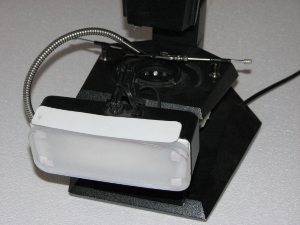
Michael: White diffusers like the one on the GIA microscope light reduce the visible light intensity by absorbing energy equally across all visible wavelengths including the visible violet. If it did not the quality/color of the light would change. (For example, if the VV and blue energy were attenuated more, the light quality would become yellowish, as happens in Cape Series type 1A diamonds.) The white plastic diffuser acts to lower light intensity similarly to a neutral density filter in photography, it absorbs/reduces all visible energy equally maintaining the color/quality/color temperature of the light.
This is all fact understood through spectrum analysis and colour science. The yellow tint in cape series type 1A diamonds is the result of the N3 center's greater attenuation of wavelengths in the violet and deep blue. When we observe that a filter like the one on the GIA microscope light does not change the light's quality/colour it is because all wavelengths including the visible violet have been attenuated equally.
Such white diffusers have the additional feature of reducing spectral reflections and glare. They were employed on GIA microscope lights (Figure 10) for this purpose and to filter UV. (Note that although they did a good job of reducing reflections and glare, they did not reduce the UV or the light intensity enough to avoid all grade whitening fluorescence.)
These observations are from past GIA course manuals and the measurements of UV of 9 uW and 600 fc light intensity at one inch grading distance from the microscope light with diffuser. The diffuser dropped the UV from over 150 uW to 9uW and the light intensity from 1000fc to 600fc. That was insufficient to avoid all grade whitening fluorescence from either the UV or the visible light. (Note that GIA's lighting specifications require light intensity to be between 200fc and 450fc ( 2000lux and 4500lux).

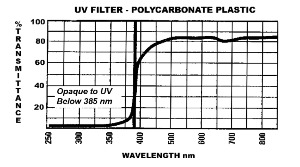
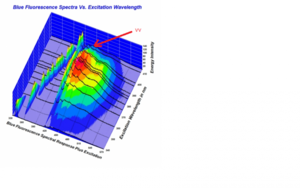
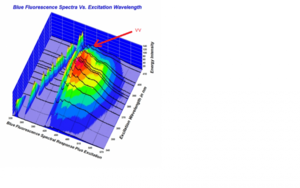
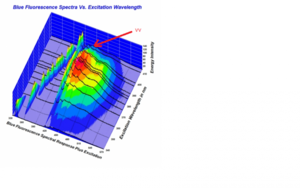
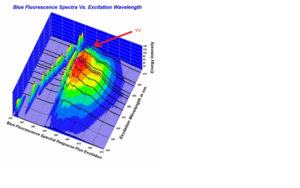
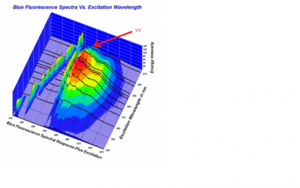
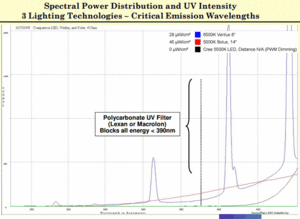
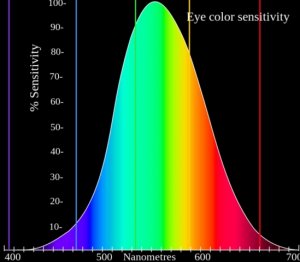
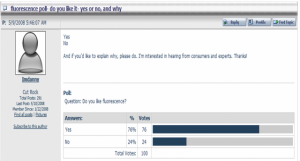
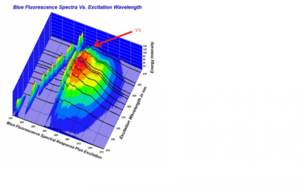
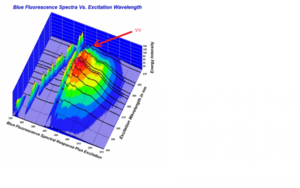
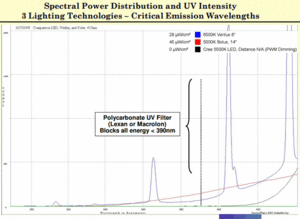
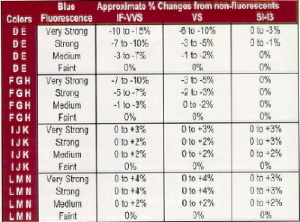


300x240.png)